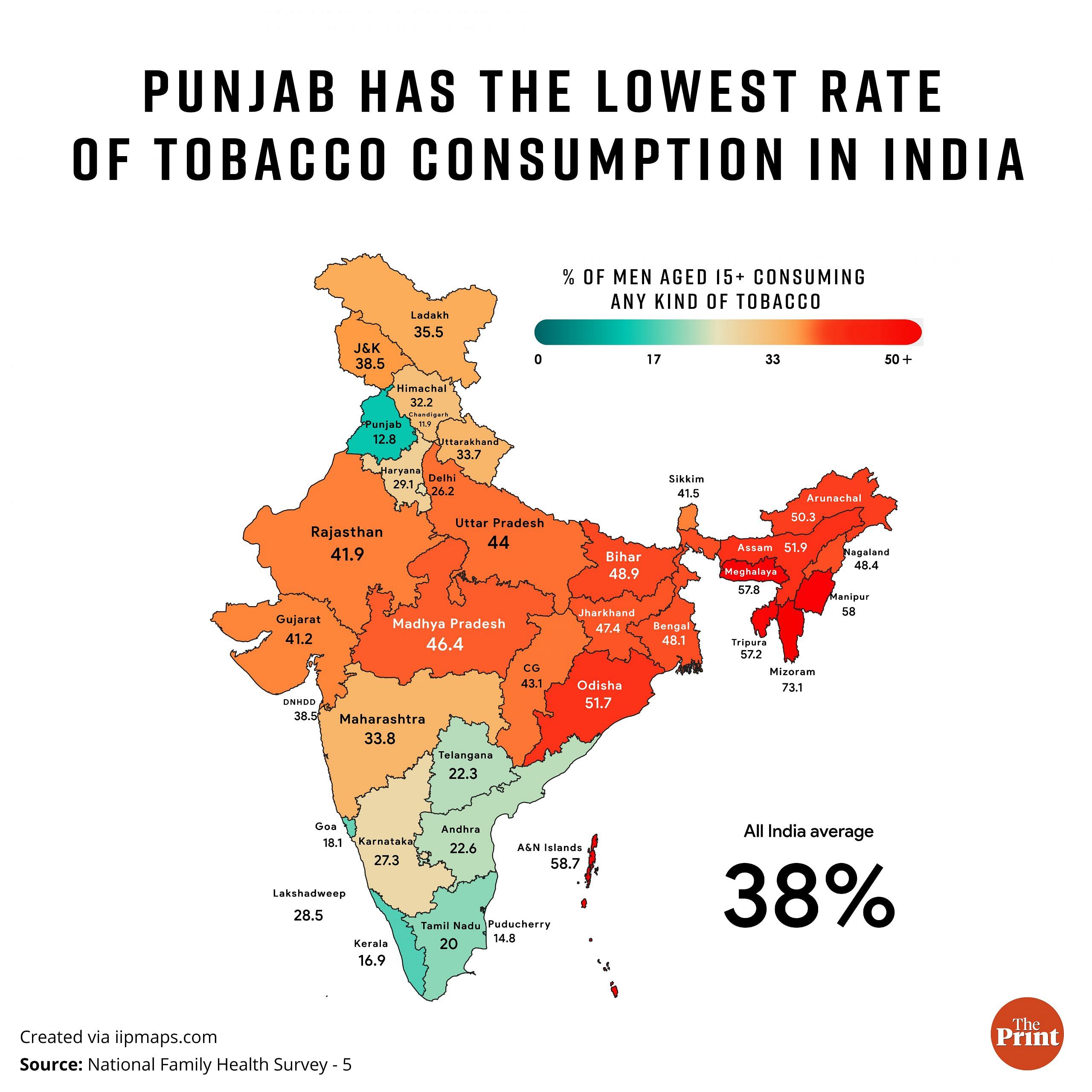New Delhi: On World Anti-Tobacco Day, a recap of various surveys in recent years shows tobacco consumption is on a decline in India.
And then, there are some findings that reveal worrying trends. Consider this: India In Pixels — a data visualisation portal — shows paan spit from just three states — Uttar Pradesh, Bihar and Odisha — can fill up 105 Olympic sized swimming pools.
Conducted by the Tata Institute of Social Sciences and the Ministry of Health and Family Welfare in 2016-17, the second round of Global Adult Tobacco Survey (GATS) shows that the share of men who consumed tobacco was down from 47.9 percent in 2009-10 to 42.4 percent.
The fall of tobacco consumption was relatively higher among women. In 2009-10, about 20.3 per cent women consumed any form of tobacco, which fell to 14.2 per cent by 2016-17.
But, where in India are people least likely to use tobacco? Turns out it is Punjab.

Covering the years from 2019 to 21, the National Family Health Survey-5 also shows that about 38 percent men (more than one in three) and 8.9 percent women (or less than one in 10) above 15 years consumed tobacco in India.
What type of tobacco Indians consume?
According to the NFHS survey, chewing forms of tobacco — paan masala and gutka — was the most common form of tobacco consumption in India. For about 15 percent of men, paan masala or gutka was the most common way of consuming tobacco, followed by cigarettes (13 percent), khaini (12 percent) and bidis (7 percent). It also mentioned that among those who smoked bidis, about 46 percent smoked more than five sticks everyday.
Of all the 28 states and 8 Union Territories (UTs), Punjab and Chandigarh had the lowest rate of tobacco consumption in India. According to the NFHS-5 data, barely 13 percent men and 0.4 percent women in Punjab and 12 percent men and 0.6 percent women in Chandigarh used tobacco.
Besides Punjab and Chandigarh, there were only three states — Kerala (17 percent ), Goa (18 percent), and Tamil Nadu (20 percent).— and one UT — Puducherry (less than 15 percent) — where tobacco consumption was at most 20 percent among men.
Consumption of tobacco among men is high in the Northeast, where Mizoram (73 percent) tops the list both region-wise as well as nationally. Next comes Manipur (58 percent), followed by Meghalaya (57.8 percent), Tripura (57.2 percent) and Assam (51.9 percent). Arunachal Pradesh also falls in the 50 percent plus category.
Outside Northeast, Bihar (nearly 49 percent) and Uttar Pradesh (44 percent) also have a large section of their men consuming tobacco.
Also Read: 1.7 lakh tonnes of waste per year — ICMR-AIIMS study calculates environmental toll of tobacco use
Why Punjab has the lowest?
While smoking is considered to be a personal choice, it is also cited to be a cultural phenomenon. Research has shown that smoking often tends to be a cultural phenomenon, meaning it’s more prevalent in cultures where the acceptance is high.
The same holds true in Punjab, where the Sikhs — according to the 2021 Census — comprise 57.69 percent of its population. Anyone familiar with Sikhism can recall that it prohibits smoking.
This fact is reiterated by the NFHS data which establishes that compared to any other religious community, the prevalence of Sikhs consuming tobacco products is the lowest.

While on an average more than one in three Indian men consume tobacco, this ratio drops to one in five when it comes to Punjab. The proportion is pronounced in the case of women — the ratio is 1:250 in Punjab as compared to 1:12 in the country.
The NFHS data also shows that the likelihood of a doctor advising people to quit tobacco consumption is among the highest in Punjab. In fact, over 82 percent of men in Punjab and 100 percent of them in Chandigarh were advised to do so. The national percentage stood at 53.
Despite having a relatively lower number of tobacco consumers, the percentage of Sikh men getting medical advice to quit any form of tobacco was the highest. Consider this: 76 percent of the Sikh men received advice to quit tobacco, followed by Hindus (54.6 percent), Muslim (51 percent), Christians (46 percent), Jains (49 percent) and others (44 percent).
The NFHS report also throws light on the harmful effects of tobacco consumption in general.
“Tobacco use is associated with a wide range of diseases, including several types of cancers and heart and lung diseases, diabetes, eye disease, and rheumatoid arthritis,” it said.
“Studies have shown that in addition to sharing the same health risks as men, women who use tobacco experience difficulty in becoming pregnant and are at an increased risk of infertility, pregnancy complications, premature births, low birth-weight infants, stillbirths, miscarriages, and infant deaths,” the report added.
(Edited by Tony Rai)
Also Read: Hard-won gutka ban is now under threat. This time from courts



